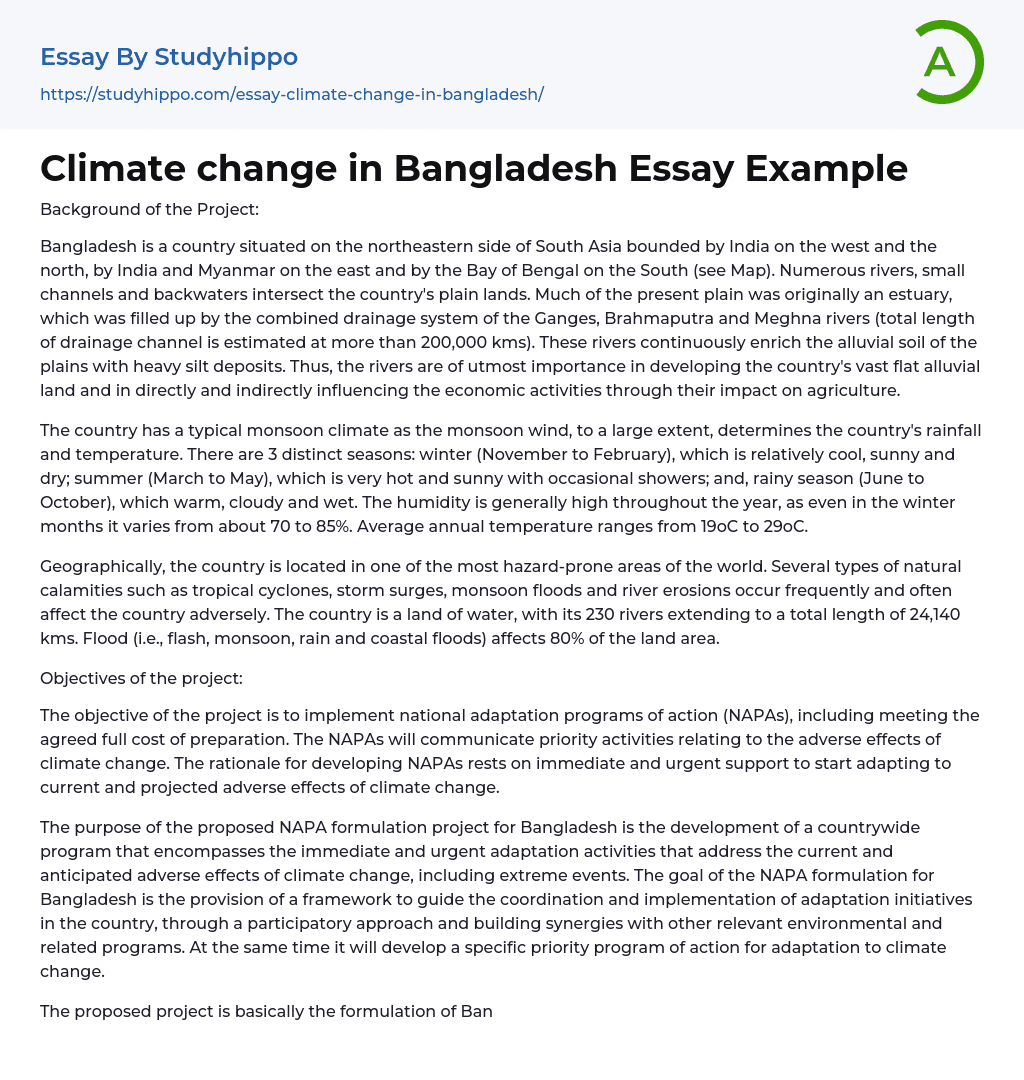Background of the Project:
Bangladesh, situated in South Asia's northeastern region, shares borders with India to the west and north, as well as India and Myanmar to the east. Its southern side is bordered by the Bay of Bengal (refer to Map). The country's flatlands are intersected by numerous rivers, small channels, and backwaters. These plains were originally an estuary that has been filled up by the combined drainage system of three rivers: Ganges, Brahmaputra, and Meghna. The overall length of this drainage channel is estimated to exceed 200,000 kilometers.
The rivers are essential for the nation's flat alluvial land as they continuously deposit heavy silt into the soil. They have both direct and indirect impacts on economic activities, especially in agriculture. The rainfall and temperature of the country are determined by the monsoon wind, resulting in a typical m
...onsoon climate with three distinct seasons: winter (November to February) characterized by cool, sunny, and dry conditions; summer (March to May) with intense heat, sunlight, and occasional showers; and rainy season (June to October) marked by warm, cloudy, and wet weather. The humidity remains consistently high at around 70 to 85% throughout the year, even during winter months.
The country is situated in a hazard-prone area with an average annual temperature range of 19oC to 29oC. This leads to frequent natural disasters like tropical cyclones, storm surges, monsoon floods, and river erosions, which often have a detrimental effect on the country. Furthermore, the country is renowned for its plentiful water resources. It boasts 230 rivers that cover a total length of 24,140 kms. Around 80% of the land area experiences various types of flooding including flash floods, monsoon floods
rain floods, and coastal floods.
Objectives of the project:
The main objective of this project is to fully fund the implementation of national adaptation programs of action (NAPAs), which prioritize activities addressing the negative impacts caused by climate change. The development of NAPAs aims to provide immediate and urgent support in adapting to current and projected adverse effects of climate change. The proposed NAPA formulation project for Bangladesh seeks to create a comprehensive program that includes immediate and urgent adaptation activities, specifically targeting current and anticipated adverse effects such as extreme events. This project aims to establish a participatory framework that guides coordination and implementation of adaptation initiatives throughout Bangladesh, collaborating with other relevant environmental and related programs.
The proposed project aims to formulate a program of action on adaptation to climate change specifically for Bangladesh. It will involve conducting assessments and analyses of previous work on the subject, as well as collecting additional data through updating and verification, and supplementary desk research. The main goal is to develop a country-driven program that addresses the urgent and immediate needs and concerns of Bangladesh in relation to the adverse effects of climate change. Immediate support is crucial to help the country start adapting to the current and anticipated adverse effects of climate change. Delaying such support could increase the country's vulnerability or lead to higher intervention costs in the future.
The 5th Five Year National Development Plan of the country aims to strengthen cooperation with the international community in addressing threats to sustainable development, such as climate change. The plan also identifies human and financial resource shortages as major issues that need resolving.
To execute the project, the first step
is to establish coordination mechanisms among key stakeholders. This will be followed by engaging multi-level support mechanisms to ensure widespread ownership of project outputs, including consultations across the country. To achieve this, a NAPA Team led by a designated lead agency and representatives from government agencies and civil society will be established.
The formulation of the NAPA for Bangladesh will be supported by the development of a specialized methodology to assess the country's adaptation to climate change and vulnerability to climate variability. This methodology will be utilized in relevant studies and research, specifically tailored for Bangladesh. Multi-disciplinary teams will be created to carry out initial assessments and aid in identifying priority sectors. These teams will conduct thorough analyses using the designated methodology, with the findings and recommendations informing the NAPA formulation process. Throughout this process, consultation and participation will be given high priority.
The assessments will lead to a report, forming the basis for creating the national strategy and action plan for climate change adaptation, known as NAPA. The action plan will be shared with national and international stakeholders and submitted to government authorities for approval. It will provide guidance to relevant stakeholders in developing and executing climate change adaptation programs within the country. Moreover, it will be distributed to private investors and international bilateral and multilateral donor agencies interested in implementing climate change adaptation projects in Bangladesh.
- flood essays
- Traffic essays
- Renewable Energy essays
- Carbon Dioxide essays
- Greenhouse Gas essays
- Ecology essays
- Pollution essays
- Environmental Issues essays
- Air Pollution essays
- Nature essays
- Water Pollution essays
- Climate essays
- Hurricane essays
- Tornado essays
- Tsunami essays
- Endangered Species essays
- Deforestation essays
- Environmental Protection essays
- Sustainability essays
- Stream essays
- Environmental Disaster essays
- Sustainable Development essays
- Environment Pollution essays
- Plastic Pollution essays
- Animal Welfare essays
- Zoo essays
- Plastic essays
- Waste Management essays
- Climate Change essays
- Global Warming essays
- Conservation essays
- Recycling essays
- Oxygen essays
- Atmosphere essays
- Coral Reef essays
- Desert essays
- Earth essays
- Ocean essays
- Lake essays
- Sea essays
- Biodiversity essays
- Natural Environment essays
- Forest essays
- Soil essays
- Water essays
- Rainbow essays
- Ecosystem essays
- Volcano essays
- Wind essays
- Forestry essays




